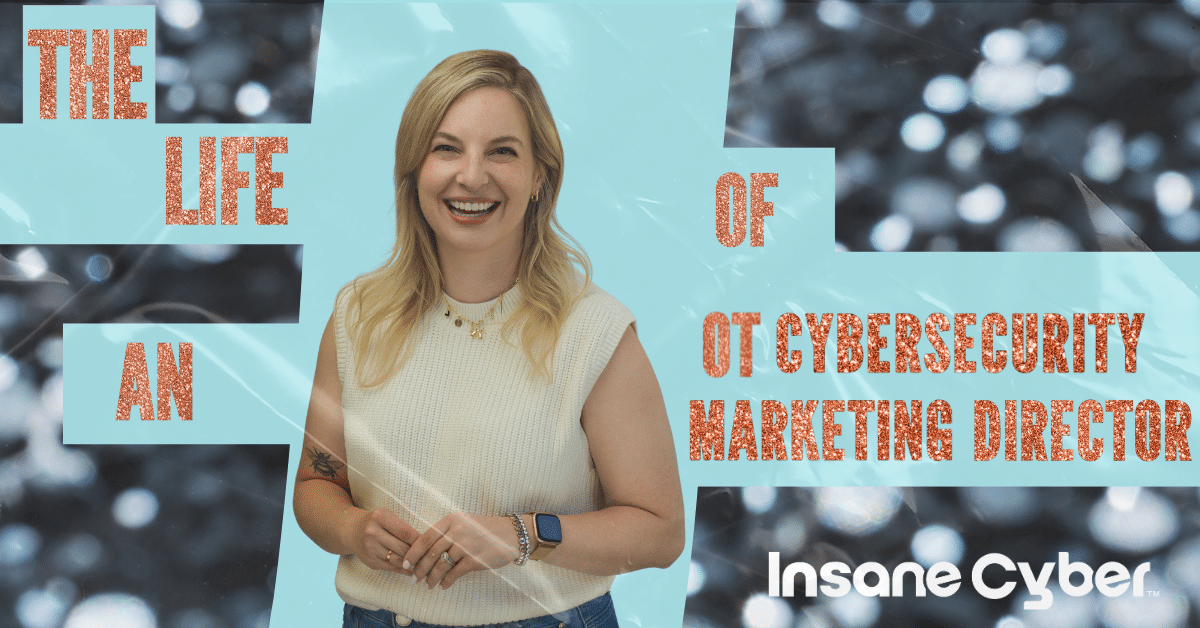By Samantha Becker, Marketing Director at Insane Cyber
Article originally posted on LinkedIn.
When I first started working for Insane Cyber in OT cybersecurity, I’ll be honest—I had no idea what I was getting into. I knew enough about IT and thought it would be roughly the same. I thought it was going to be all about firewalls, acronyms, and maybe some fancy dashboards with blinking lights.
What I didn’t expect was how eye-opening (and a little nerve-wracking) it would be to learn just how much is at stake when it comes to securing the systems that literally keep the lights on. I look at the world through a different lens now. Over time, after sitting through countless conversations with asset owners, engineers, analysts, and operators, I’ve picked up a few lessons that stuck with me.
So grab your guitar, your coffee, and your OT network diagrams—this is OT Cybersecurity: Sam’s Version.
Track 1: You Belong With Me (On the Network Map)

One of the first things I learned was that a lot of organizations don’t really know what’s on their networks. At all. Imagine trying to protect your house, but you’re not sure how many doors or windows it has—or whether they’re locked. That’s what it’s like in many OT environments.
For me, that was the first “whoa” moment: realizing how much of our infrastructure is flying blind. It’s both scary and motivating, because the second you shine a light on those blind spots, you’re already ahead of the game.
Track 2: The Last Time (You Checked Your PLCs)

I used to think of cyberattacks in terms of stolen credit card numbers or hacked email accounts—both of which have happened to me. But in OT, the impact is so much bigger. We’re talking about water systems, pipelines, energy grids. If something goes wrong here, it’s not just an IT team scrambling—it’s people losing access to the things they depend on every day.
Once I started to learn about what these cyber events look like in real life, that shift in perspective changed everything for me.
Track 3: Begin Again (Proactive Cyber Edition)

Another misconception I had early on was that cybersecurity is all reactionary: bad guy breaks in, good guys scramble to clean up. Turns out, owners and operators can do a lot before anything happens.
From tabletop exercises to better segmentation and monitoring, there are tons of proactive steps that make a huge difference. It’s not the dramatic Hollywood version of cyber, but it’s way more practical—and it gives organizations a fighting chance. Just think, if John Hammond had done a tabletop exercise before his soft opening of Jurassic Park, the movie would have been a lot less interesting.
Track 4: All Too Well (The 10-Year Legacy System Version)

When I started learning the ways attackers could get into an OT environment, my brain basically short-circuited. Phishing? Sure. But then add in supply chain vulnerabilities, poorly configured remote access, legacy equipment with zero built-in security, and even good old-fashioned USB drives.
We’re still using these? That’s the thing about OT systems—a lot of these are legacy systems that don’t get the same frequent updates as IT systems.
Track 5: Snow on the Plant Floor
 “Weird, but it’s OT… like snow on the beach.”
“Weird, but it’s OT… like snow on the beach.”
If you’ve seen one factory, you’ve seen… well, just that one factory. No two environments are alike. Each has its own legacy systems, vendor mix, and quirks. That means what works in one place might completely flop in another.
OT environments are like snowflakes—unique and kind of beautiful in their complexity, but also, you don’t want them melting down on you.
Bonus Track: Long Live the OT Cyber Heroes

The best part of this industry? The people. Hands down. I’ve met engineers, analysts, and operators who aren’t just passionate—they’re relentless in their mission to protect critical infrastructure.
They share knowledge, mentor others, and collaborate across companies not for recognition, but because they genuinely care about keeping the lights on, the water running, and our world safe. In a field that can feel daunting and high-stakes, this community is a reminder that you’re never in it alone.
As a marketer, I’ve been welcomed into conversations I never imagined I’d be part of. I’ve learned by listening, by asking questions, and by being surrounded by people who care deeply about solving the hardest cybersecurity challenges.
So here’s to the OT defenders, the unsung heroes behind every SCADA screen, every network diagram, and every midnight incident response call.
Long live this community. Long live your passion. Long live your impact.
Closing Chorus
The OT cybersecurity industry is equal parts daunting and inspiring. The threats are real, the stakes are high, and the challenges are complex. Every call I sit on, each show I attend, and every conversation leaves me optimistic—because there’s an entire community of people determined to solve the hardest cybersecurity challenges.
Spotlights down, network diagrams up—this industry is a stadium tour of high stakes and higher impact. The threats are real, the challenges are complex, but every conversation, every tabletop exercise, every show floor handshake reminds me: we’re not just keeping systems running; we’re keeping the world turning.
To the engineers, operators, and analysts: you’re the headliners. You’re the ones patching, segmenting, hunting, and protecting under the radar while the rest of the world sleeps soundly, never realizing the battles you’ve already won.
And to the cyber community: this is your standing ovation moment. Long live the defenders, the builders, the quiet heroes of OT. Long live the sleepless nights and the victories no one else will ever see. Long live the people who never stop showing up.
Because in the end, this is more than cyber.
This is courage, creativity, and resilience—OT’s Version.



